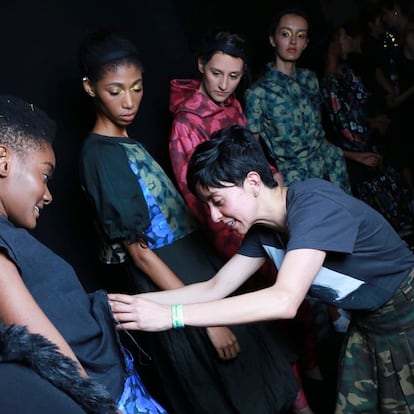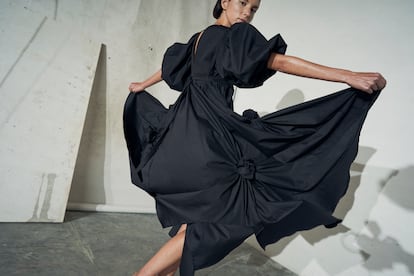Where do military uniforms end up? In Colombia, fashion experiments with reusing camouflage
The Colombian designer Laura Laurens makes dresses out of fabric that was considered waste. She has shown her work at Paris and London Fashion Week

Where do uniforms end up? What happens to those sophisticated technical garments, made from specially formulated fabrics, which military and police forces switch out regularly? Where do those uniforms go, given that, for security reasons, they can’t be left in just anyone’s hands? These questions began to assail the mind of the Colombian artist and fashion designer Laura Laurens, who in 2014, in the midst of the negotiations of the peace agreement between the former guerrilla, the FARC, and the Colombian government, was working to bring her first collection to Paris Fashion Week, obsessed with minimizing her brand’s environmental impact.
Laura began to explore the textiles that had been involved in the Colombian war. She made a surprising discovery: the armed groups, government-backed and not, dressed in the same fabric. The cotton weave, known as rip stop, had lightweight qualities ideal for hot climates and a resistance to cold humidity.
“The uniforms of the different armed groups were made with the same fiber. I then considered how to turn that material into a metaphor of territory for unification, how to unite opposites around a fabric that had been the emblematic sign of the war and turn it into something beautiful, appetizing,” explains the designer, who found herself with an immense amount of camouflaged fabrics that had been discarded because of imperfections.

“I started working with these stock fabrics and transforming them by diluting the greens, deliberating showing off the the tears and wear on some pieces, using traditional camouflage, but adding brushstrokes of gold and giving them elegant shapes that would be unthinkable with this type of fabric,” explains Laurens. She called the material “the new denim,” and she turned it into the base of the deconstructed asymmetrical dresses that appealed to clients the world over.
In her collection Green Military, the greenness of the material typically used for camping tents contrasted with gradients and layered skirts. In Camouflage, the pattern became parka-like jackets with denim patches. For the Rotter Flowers collection, women artisans from the Colombian Pacific worked draping the military fabrics dyed and intervened by the designer, turning them into a garden of roses. Since then, Laurens has worked with artisans for all of her collections, “with their knowledge, helping to recover the fabric.”
“For me, sustainability work is not only about taking advantage of what already exists, but also about exploring how social processes are integrated, using the visibility of fashion to reveal unknown realities and create community projects. Without social justice, there is no environmental justice,” says Laurens.
Her project is not the only one with an interest in reusing the enormous wave of fabrics that come from military uniforms. In 2019, the NGO Transformador, headed by Lorena Mejía and Iván Sánchez, led a project that sought to provide a creative and ecological outlet for the more than 360,000 uniforms that the Colombian police were obliged to switch out every 12 months.

“Each year, with many of the uniforms still in perfect condition, a volume of approximately one million tons of fabric [is discarded]. All of that went to landfills or became, in its best version for reuse, kitchen rags for police stations,” explains Mejía, who tried to create a complex mechanism so that the uniforms could be collected, their logos and brands expunged, to become raw material for, for example, new bags for the police.
Although the logistics behind this idea became more complicated, given the strict guidelines around transporting and using the fabrics, the NGO struck a chord with 17 renowned designers who demonstrated how these fabrics, once seen as waste, contained the potential to become valuable new fashion items. “In part, we seek to knock down the stigma that things created with reused materials have a certain look or cannot become beautiful and desirable garments,” explains Mejía.
That is just one of the paradigms that Laurens has challenged over the years. “When one is faced with a material like this – a bit rough, far from the ideals of elegance, a bit imperfect, often worn out— it is difficult to imagine how it can create interesting contemporary dresses and that can have success in different markets. But that is the challenge that we face more and more, to give a new life to what we have at hand and turn the ordinary into something extraordinary,” concludes the designer. She hopes that now, with an environment more respectful of the peace agreements in Colombia, she can work with the government on another scale to use and transform the uniforms that officials discard.
Sign up for our weekly newsletter to get more English-language news coverage from EL PAÍS USA Edition
Tu suscripción se está usando en otro dispositivo
¿Quieres añadir otro usuario a tu suscripción?
Si continúas leyendo en este dispositivo, no se podrá leer en el otro.
FlechaTu suscripción se está usando en otro dispositivo y solo puedes acceder a EL PAÍS desde un dispositivo a la vez.
Si quieres compartir tu cuenta, cambia tu suscripción a la modalidad Premium, así podrás añadir otro usuario. Cada uno accederá con su propia cuenta de email, lo que os permitirá personalizar vuestra experiencia en EL PAÍS.
¿Tienes una suscripción de empresa? Accede aquí para contratar más cuentas.
En el caso de no saber quién está usando tu cuenta, te recomendamos cambiar tu contraseña aquí.
Si decides continuar compartiendo tu cuenta, este mensaje se mostrará en tu dispositivo y en el de la otra persona que está usando tu cuenta de forma indefinida, afectando a tu experiencia de lectura. Puedes consultar aquí los términos y condiciones de la suscripción digital.
More information

Colorimetry: The art of finding the colors that suit you best

How Wednesday Addams became a gothic style icon
Archived In
Últimas noticias
Trump claims peace in Ukraine is near, but Moscow suggests otherwise
A survivor’s account of the Interoceanic Train accident: ‘We were scared because of the speed on the curve’
The Interoceanic Train, the Mexican alternative to the Panama Canal
What is known about the Interoceanic Train derailment in Oaxaca
Most viewed
- Oona Chaplin: ‘I told James Cameron that I was living in a treehouse and starting a permaculture project with a friend’
- Reinhard Genzel, Nobel laureate in physics: ‘One-minute videos will never give you the truth’
- Why the price of coffee has skyrocketed: from Brazilian plantations to specialty coffee houses
- Pablo Escobar’s hippos: A serious environmental problem, 40 years on
- Chevy Chase, the beloved comedian who was a monster off camera: ‘Not everyone hated him, just the people who’ve worked with him’








































